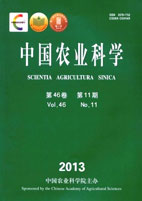-
Responses of Spectral Reflectance, Photosynthesis and Chlorophyll Fluorescence in Cotton During Drought Stress and Rewatering
- XUE Hui-Yun, ZHANG Yong-Jiang, LIU Lian-Tao, SUN Hong-Chun, LI Cun-Dong
-
Scientia Agricultura Sinica. 2013, 46(11):
2386-2393.
doi:10.3864/j.issn.0578-1752.2013.11.024
-
 Abstract
(
743 )
Abstract
(
743 )
 PDF (549KB)
(
1118
)
PDF (549KB)
(
1118
)
 Save
Save
-
References |
Related Articles |
Metrics
【Objective】 The objective of this paper was to identify photosynthetic and spectral indicators related to drought stress through analysis of photosynthetic traits and spectral index in cotton (Gossypium hirsutum L.). 【Method】 The transgenic cotton cultivar Yinrui 361 was used as material, leaf spectral reflectance, photosynthesis and chlorophyll fluorescence characteristics were studied by a pot experiment during the continuous drought stress and rewatering.【Result】Two years results indicated that leaf relative water content (RWC), net photosynthesis (Pn), stomatal conductance (Gs), transpiration rate (Tr), maximal photochemical efficiency of PSⅡ in the dark (Fv/Fm), actual photochemical efficiency of PSⅡ in the light (ΦPSII), photochemical quenching coefficient (qP) and photochemical reflectance index (PRI) showed a downward trend along with the prolonging of the drought stress. Stomatal limitation value (Ls) increased at the early time, and then decreased later. While non-photochemical quenching coefficient (NPQ) showed an increasing trend. After rewatering, most parameters could not recover to the initial state except RWC. Compared with the initial state on two-year average, Pn, Gs, Tr, Fv/Fm, ΦPSII, qP and PRI in the 4th day of stress decreased by 53.1%, 79.9%, 66.0%, 3.8%, 11.0%, 5.7% and 18.4%, respectively. While Ls and NPQ increased by 98.1% and 28.6%, respectively. Among them, only Pn, Gs, Tr, Ls, Fv/Fm and PRI had significant differences between values in the 4th day and the initial state, and R2 were 0.7640, 0.7058, 0.5625, 0.3665, 0.7319 and 0.4378, respectively. 【Conclusion】 It was concluded that Pn, Gs, Tr, Ls, Fv/Fm and PRI could be considered as reliable indicators in cotton leaves at the first stage of drought stress, while Pn, Gs, Fv/Fm can sensitively and accurately reflect the water condition of cotton leaves under continuous drought stress.









